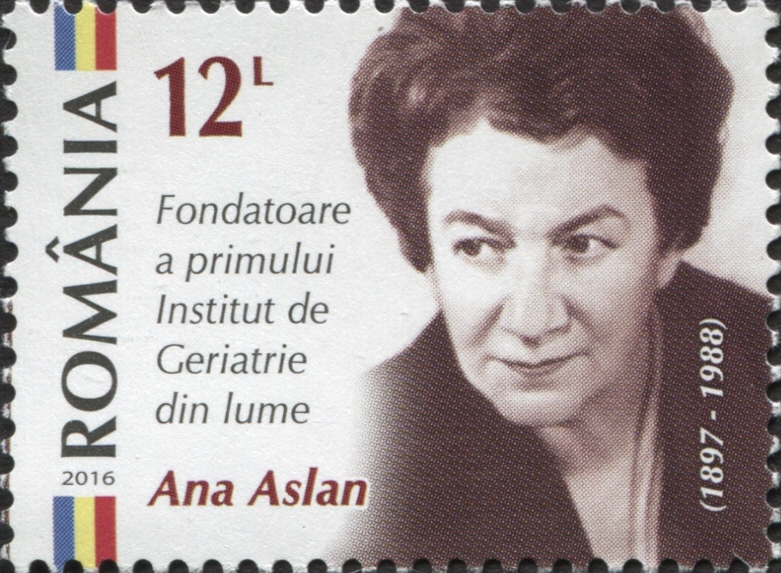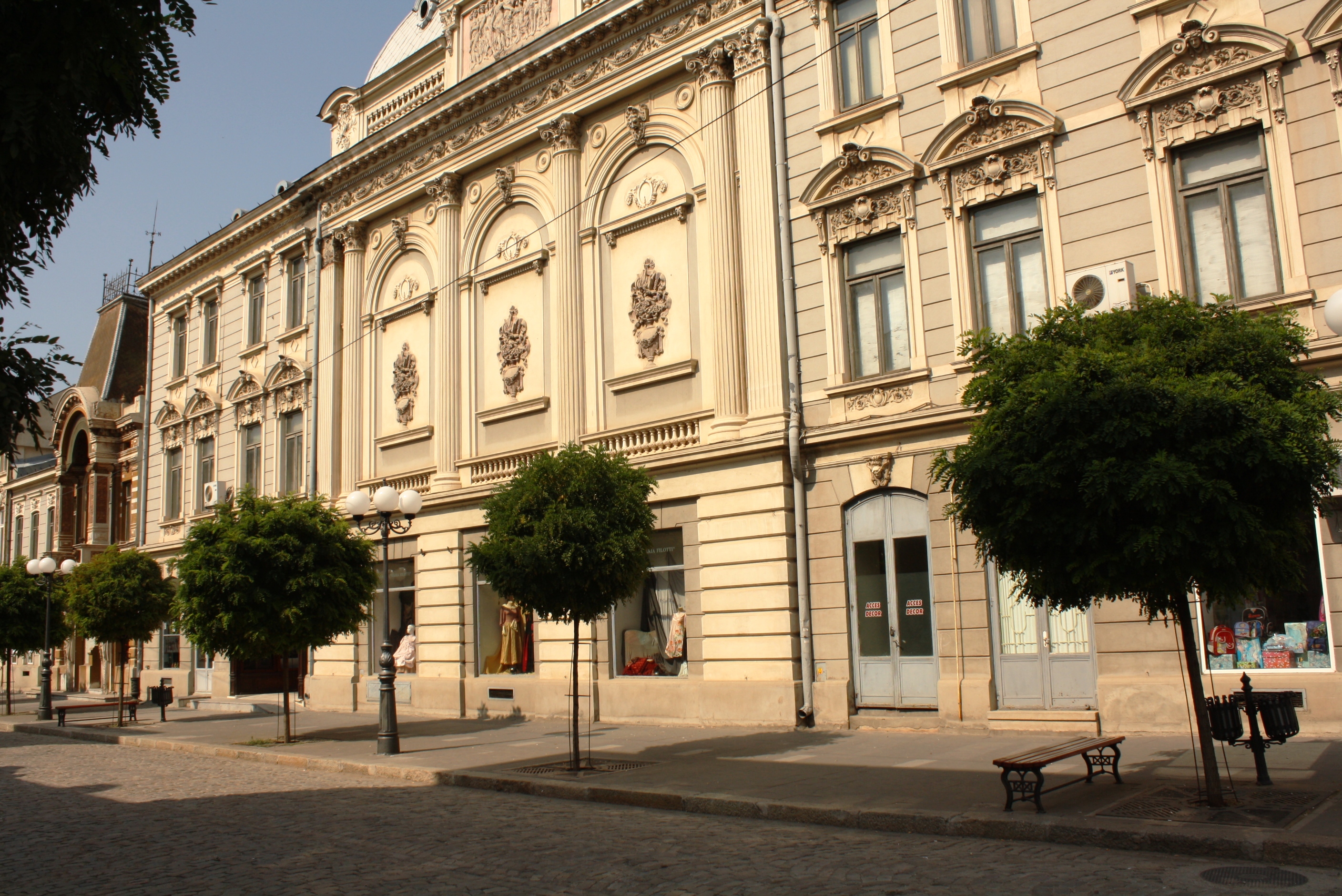|
Ana Aslan
Ana Aslan (; born 1 January 1897, Braila, Kingdom of Romania – died 20 May 1988, Bucharest, Socialist Republic of Romania) was a Romanian biologist and physician, specialist in gerontology, academician from 1974 and the director of thNational Institute of Geriatrics and Gerontology(1958 - 1988). Early life Ana was the youngest of four children, two brothers and two sisters, born to Margarit and Sofia Aslan. Ana was said to be a very intellectual child, learning to read and write already by age four. At the age of 13, her father died, and her family then moved to Bucharest, Romania. It was in Bucharest where she began her studies. She graduated from the Central School of Bucharest in 1915. The premature death of her father, whom she was close to, was said to be the reason she wanted to become a physician. Although the medical field was not a desirable field for women to enter, Ana Aslan decided that was the path she wanted to pursue and attended the Faculty of Medicine fr ... [...More Info...] [...Related Items...] OR: [Wikipedia] [Google] [Baidu] |
Brăila
Brăila (, also , ) is a city in Muntenia, eastern Romania, a port on the Danube and the capital of Brăila County. The ''Sud-Est'' Regional Development Agency is located in Brăila. According to the 2011 Romanian census there were 180,302 people living within the city of Brăila, making it the 11th most populous city in Romania. The current mayor of Brăila is . History Origins Before 14th century, a small village existed in the place of today's Brăila, probably inhabited by fishermen and small merchants.Rădvan, p.248 The village fell to the Mongols during the 1241 Mongol invasion of Europe and it was under direct control of the rulers of Argeș in mid-14th century. A settlement called ''Drinago'' was found in several 14th century Catalan and Castillian portolan charts ( Angelino de Dalorto, 1325/1330 and Angelino Dulcert, 1339), as well as in the ''Book of Knowledge of All Kingdoms''. This may have been an erroneous transcription of ''Brillago'', a name which was l ... [...More Info...] [...Related Items...] OR: [Wikipedia] [Google] [Baidu] |
1974
Major events in 1974 include the aftermath of the 1973 oil crisis and the resignation of United States President Richard Nixon following the Watergate scandal. In the Middle East, the aftermath of the 1973 Yom Kippur War determined politics; following Israeli Prime Minister Golda Meir's resignation in response to high Israeli casualties, she was succeeded by Yitzhak Rabin. In Europe, the invasion and occupation of northern Cyprus by Turkish troops initiated the Cyprus dispute, the Carnation Revolution took place in Portugal, and Chancellor of West Germany Willy Brandt resigned following an espionage scandal surrounding his secretary Günter Guillaume. In sports, the year was primarily dominated by the FIFA World Cup in West Germany, in which the German national team won the championship title, as well as The Rumble in the Jungle, a boxing match between Muhammad Ali and George Foreman in Zaire. Events January–February * January 26 – Bülent Ecevit of CHP forms the ne ... [...More Info...] [...Related Items...] OR: [Wikipedia] [Google] [Baidu] |
Fountain Of Youth
The Fountain of Youth is a mythical spring which allegedly restores the youth of anyone who drinks or bathes in its waters. Tales of such a fountain have been recounted around the world for thousands of years, appearing in the writings of Herodotus (5th century BC), in the Alexander romance (3rd century AD), and in the stories of Prester John (early Crusades, 11th/12th centuries AD). Stories of similar waters also featured prominently among the people of the Caribbean during the Age of Exploration (early 16th century); they spoke of the restorative powers of the water in the mythical land of Bimini. Based on these many legends, explorers and adventurers looked for the elusive Fountain of Youth or some other remedy to aging, generally associated with magic waters. These waters might have been a river, a spring or any other water-source said to reverse the aging process and to cure sickness when swallowed or bathed in. The legend became particularly prominent in the 16th century, ... [...More Info...] [...Related Items...] OR: [Wikipedia] [Google] [Baidu] |
Gerovital H3
Gerovital H3 (or procaine hydrochloride and products known as GH3 and other variants which may or may not be identical to Gerovital H3) is a preparation developed during the 1950s and promoted by its advocates as an effective anti-aging treatment. In the United States, the FDA bans Gerovital H3 from interstate commerce as an unapproved drug and, since 1982, has prohibited its importation. Gerovital is promoted with unsupported claims of its curative abilities for a wide range of human ailments; research has found no evidence that it has any health benefit or "anti-aging" properties. Development and marketing The impetus for developing the drug is sometimes alleged to have come from Nicolae Ceaușescu, who is also wrongly claimed to have funded the establishment of a research organization, the National Institute of Geriatrics, in Bucharest, Romania, headed by Ana Aslan (1897–1988). From the 1950s until her death in 1988, Aslan promoted Gerovital H3 with great success. In ... [...More Info...] [...Related Items...] OR: [Wikipedia] [Google] [Baidu] |
Arthritis
Arthritis is a term often used to mean any disorder that affects joints. Symptoms generally include joint pain and stiffness. Other symptoms may include redness, warmth, swelling, and decreased range of motion of the affected joints. In some types of arthritis, other organs are also affected. Onset can be gradual or sudden. There are over 100 types of arthritis. The most common forms are osteoarthritis (degenerative joint disease) and rheumatoid arthritis. Osteoarthritis usually occurs with age and affects the fingers, knees, and hips. Rheumatoid arthritis is an autoimmune disorder that often affects the hands and feet. Other types include gout, lupus, fibromyalgia, and septic arthritis. They are all types of rheumatic disease. Treatment may include resting the joint and alternating between applying ice and heat. Weight loss and exercise may also be useful. Recommended medications may depend on the form of arthritis. These may include pain medications such as ibuprofen ... [...More Info...] [...Related Items...] OR: [Wikipedia] [Google] [Baidu] |
Procaine
Procaine is a local anesthetic drug of the amino ester group. It is most commonly used in dental procedures to numb the area around a tooth and is also used to reduce the pain of intramuscular injection of penicillin. Owing to the ubiquity of the trade name Novocain or Novocaine, in some regions, procaine is referred to generically as novocaine. It acts mainly as a sodium channel blocker. Today it is used therapeutically in some countries due to its sympatholytic, anti-inflammatory, perfusion-enhancing, and mood-enhancing effects. Procaine was first synthesized in 1905, shortly after amylocaine. It was created by the chemist Alfred Einhorn who gave the chemical the trade name Novocaine, from the Latin ''nov-'' (meaning "new") and ''-caine'', a common ending for alkaloids used as anesthetics. It was introduced into medical use by surgeon Heinrich Braun. Prior to the discovery of amylocaine and procaine, cocaine was a commonly used local anesthetic. Einhorn wished his n ... [...More Info...] [...Related Items...] OR: [Wikipedia] [Google] [Baidu] |
Ageing
Ageing ( BE) or aging ( AE) is the process of becoming older. The term refers mainly to humans, many other animals, and fungi, whereas for example, bacteria, perennial plants and some simple animals are potentially biologically immortal. In a broader sense, ageing can refer to single cells within an organism which have ceased dividing, or to the population of a species. In humans, ageing represents the accumulation of changes in a human being over time and can encompass physical, psychological, and social changes. Reaction time, for example, may slow with age, while memories and general knowledge typically increase. Ageing increases the risk of human diseases such as cancer, Alzheimer's disease, diabetes, cardiovascular disease, stroke and many more. Of the roughly 150,000 people who die each day across the globe, about two-thirds die from age-related causes. Current ageing theories are assigned to the damage concept, whereby the accumulation of damage (such as DNA ox ... [...More Info...] [...Related Items...] OR: [Wikipedia] [Google] [Baidu] |
Physiology
Physiology (; ) is the scientific study of functions and mechanisms in a living system. As a sub-discipline of biology, physiology focuses on how organisms, organ systems, individual organs, cells, and biomolecules carry out the chemical and physical functions in a living system. According to the classes of organisms, the field can be divided into medical physiology, animal physiology, plant physiology, cell physiology, and comparative physiology. Central to physiological functioning are biophysical and biochemical processes, homeostatic control mechanisms, and communication between cells. ''Physiological state'' is the condition of normal function. In contrast, ''pathological state'' refers to abnormal conditions, including human diseases. The Nobel Prize in Physiology or Medicine is awarded by the Royal Swedish Academy of Sciences for exceptional scientific achievements in physiology related to the field of medicine. Foundations Cells Although there are differ ... [...More Info...] [...Related Items...] OR: [Wikipedia] [Google] [Baidu] |
Cardiovascular Physiology
Cardiovascular physiology is the study of the cardiovascular system, specifically addressing the physiology of the heart ("cardio") and blood vessels ("vascular"). These subjects are sometimes addressed separately, under the names cardiac physiology and circulatory physiology. Although the different aspects of cardiovascular physiology are closely interrelated, the subject is still usually divided into several subtopics. Heart * Cardiac output (= heart rate * stroke volume. Can also be calculated with Fick principle,palpeting method.) ** Stroke volume (= end-diastolic volume − end-systolic volume) ** Ejection fraction (= stroke volume / end-diastolic volume) ** Cardiac output is mathematically ` to systole ** Inotropic, chronotropic, and dromotropic states ** Cardiac input (= heart rate * suction volume Can be calculated by inverting terms in Fick principle) ** Suction volume (= end-systolic volume + end-diastolic volume) ** Injection fraction (=suction volume / end-systolic ... [...More Info...] [...Related Items...] OR: [Wikipedia] [Google] [Baidu] |
Daniel Danielopolu
Daniel Danielopolu (12 April 1884 – 29 April 1955) was a Romanian physiologist, clinician and pharmacologist Pharmacology is a branch of medicine, biology and pharmaceutical sciences concerned with drug or medication action, where a drug may be defined as any artificial, natural, or endogenous (from within the body) molecule which exerts a biochemic .... In 1938, he was elected an honorary member of the Romanian Academy. at the Romanian Academy site Notes Honorary members of the Romanian Academy[...More Info...] [...Related Items...] OR: [Wikipedia] [Google] [Baidu] |



.jpg)



